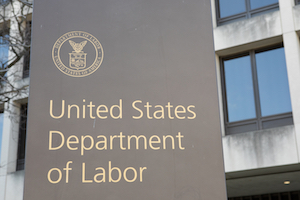 An information letter recently released by the Department of Labor addresses the application of ERISA’s bonding requirements to a pooled employer plan (PEP) established under the SECURE Act.
An information letter recently released by the Department of Labor addresses the application of ERISA’s bonding requirements to a pooled employer plan (PEP) established under the SECURE Act.
More specifically, the letter clarifies that the application of the bonding requirements to employees of employers participating in a PEP who assist in collecting and transmitting participant contributions from their employers to the PEP would not be required to be bonded under ERISA Section 412 because they would not be handling “plan funds or other property.”
The 2019 SECURE Act (Setting Every Community Up for Retirement Enhancement Act) amended ERISA to include provisions in ERISA Sections 3(43) and 3(44) authorizing PEPs sponsored by pooled plan providers as a type of multiple employer plan.
ERISA Section 3(44)(A)(iv) provides that the pooled plan provider of a PEP is responsible for ensuring that all persons who handle assets of—or who are fiduciaries of—the PEP are bonded in accordance with ERISA Section 412. In general, the requirements specify that every fiduciary of an employee benefit plan and every person who handles funds or other property of a plan to be bonded in order to protect employee benefit plans from risk of loss due to fraud or dishonesty on the part of the bonded individuals.
Section 412 Applicability
The SECURE Act also amended ERISA Section 412 to confirm that the bonding requirements of that Section apply to PEPs, except that the SECURE Act establishes $1,000,000 as the maximum bond amount as compared to $500,000 for other types of plans that do not hold employer securities.
Under DOL regulations, however, contributions to a plan do not become “funds or other property” subject to the bonding requirement until they are received by the plan administrator.
As such, according to the letter, the DOL does not view the SECURE Act as expanding the bonding requirements for PEPs to include persons who handle “assets” of the PEP or who are fiduciaries of the PEP, but do not “handle funds or other property” of the PEP. In the department’s view, the “appropriate reading” of the SECURE Act provision is that the normal Section 412 rules that govern the bonding requirements under ERISA should apply to PEPs.
For example, under ERISA Section 412, the required amount of bonding coverage is measured by the “amount of plan funds or other property” handled by a person. A person is required to be bonded in an amount equal to 10% of the plan funds or other property the person handles, subject to applicable $500,000 or $1,000,000 maximums.
“Accordingly, requiring persons dealing with PEP assets and fiduciaries of PEPs to be bonded without regard to whether they ‘handle plan funds or other property’ would result in a meaningless requirement to be bonded for a zero amount in cases in which the person did not handle plan funds or other property,” the letter advises.
Meanwhile, the DOL further cautions that there may be circumstances in which participant contributions are not timely transmitted to the PEP and become “plan assets” in the hands of the employer. Accordingly, the Section 412 bonding provisions do not relieve plan sponsors and fiduciaries of their obligations when dealing with plan assets to ensure that participant contributions are transmitted to the plan in a timely manner, the DOL emphasizes.
Independent Contractors
The DOL’s information letter further advises that pooled plan providers would be required to ensure that an independent contractor administrator or manager who handles plan funds or other property is properly bonded. This could include being covered by the bond of the PEP or by a separate bond obtained by the independent contractor administrator or manager that names the plan as an insured and meets the other requirements for bonds under ERISA Section 412, the letter explains.

